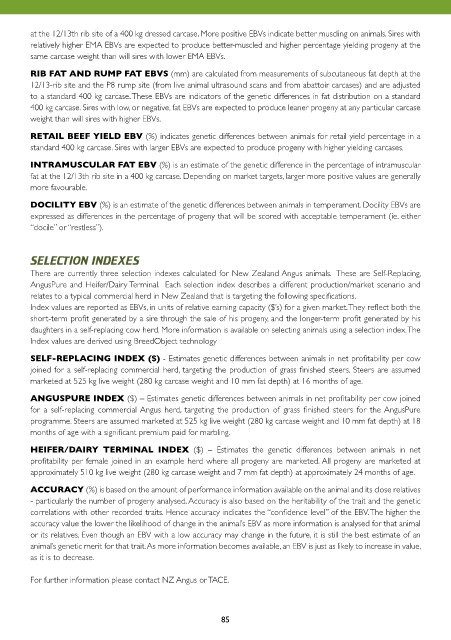Page 85 - Waitangi Angus 2021 Catalogue ebook
P. 85
at the 12/13th rib site of a 400 kg dressed carcase. More positive EBVs indicate better muscling on animals. Sires with
relatively higher EMA EBVs are expected to produce better-muscled and higher percentage yielding progeny at the
same carcase weight than will sires with lower EMA EBVs.
RIB FAT AND RUMP FAT EBVS (mm) are calculated from measurements of subcutaneous fat depth at the
12/13-rib site and the P8 rump site (from live animal ultrasound scans and from abattoir carcases) and are adjusted
to a standard 400 kg carcase. These EBVs are indicators of the genetic differences in fat distribution on a standard
400 kg carcase. Sires with low, or negative, fat EBVs are expected to produce leaner progeny at any particular carcase
weight than will sires with higher EBVs.
RETAIL BEEF YIELD EBV (%) indicates genetic differences between animals for retail yield percentage in a
standard 400 kg carcase. Sires with larger EBVs are expected to produce progeny with higher yielding carcases.
INTRAMUSCULAR FAT EBV (%) is an estimate of the genetic difference in the percentage of intramuscular
fat at the 12/13th rib site in a 400 kg carcase. Depending on market targets, larger more positive values are generally
more favourable.
DOCILITY EBV (%) is an estimate of the genetic differences between animals in temperament. Docility EBVs are
expressed as differences in the percentage of progeny that will be scored with acceptable temperament (ie. either
“docile” or “restless”).
SELECTION INDEXES
There are currently three selection indexes calculated for New Zealand Angus animals. These are Self-Replacing,
AngusPure and Heifer/Dairy Terminal. Each selection index describes a different production/market scenario and
relates to a typical commercial herd in New Zealand that is targeting the following specifications.
Index values are reported as EBVs, in units of relative earning capacity ($’s) for a given market. They reflect both the
short-term profit generated by a sire through the sale of his progeny, and the longer-term profit generated by his
daughters in a self-replacing cow herd. More information is available on selecting animals using a selection index. The
Index values are derived using BreedObject technology
SELF-REPLACING INDEX ($) - Estimates genetic differences between animals in net profitability per cow
joined for a self-replacing commercial herd, targeting the production of grass finished steers. Steers are assumed
marketed at 525 kg live weight (280 kg carcase weight and 10 mm fat depth) at 16 months of age.
ANGUSPURE INDEX ($) – Estimates genetic differences between animals in net profitability per cow joined
for a self-replacing commercial Angus herd, targeting the production of grass finished steers for the AngusPure
programme. Steers are assumed marketed at 525 kg live weight (280 kg carcase weight and 10 mm fat depth) at 18
months of age with a significant premium paid for marbling.
HEIFER/DAIRY TERMINAL INDEX ($) – Estimates the genetic differences between animals in net
profitability per female joined in an example herd where all progeny are marketed. All progeny are marketed at
approximately 510 kg live weight (280 kg carcase weight and 7 mm fat depth) at approximately 24 months of age.
ACCURACY (%) is based on the amount of performance information available on the animal and its close relatives
- particularly the number of progeny analysed. Accuracy is also based on the heritability of the trait and the genetic
correlations with other recorded traits. Hence accuracy indicates the “confidence level” of the EBV. The higher the
accuracy value the lower the likelihood of change in the animal’s EBV as more information is analysed for that animal
or its relatives. Even though an EBV with a low accuracy may change in the future, it is still the best estimate of an
animal’s genetic merit for that trait. As more information becomes available, an EBV is just as likely to increase in value,
as it is to decrease.
For further information please contact NZ Angus or TACE.
85

